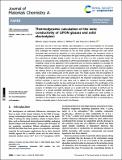Por favor, use este identificador para citar o enlazar a este item:
http://hdl.handle.net/10261/349524COMPARTIR / EXPORTAR:
 SHARE SHARE
 CORE
BASE CORE
BASE
|
|
| Visualizar otros formatos: MARC | Dublin Core | RDF | ORE | MODS | METS | DIDL | DATACITE | |

| Título: | Thermodynamic calculation of the ionic conductivity of LiPON glasses and solid electrolytes |
Autor: | López-Grande, Alberto; Mather, Glenn C. CSIC ORCID; Muñoz, Francisco CSIC ORCID | Fecha de publicación: | 31-may-2023 | Editor: | Royal Society of Chemistry (UK) | Citación: | Journal of Materials Chemistry A 2023, 11, 12282-12296 | Resumen: | [EN] LiPON films are one of the most relevant solid electrolytes in Li-ion micro-batteries for low power applications, and the relationships between composition, processing parameters and ionic conductivity have challenged the materials community for the last three decades. Although films have almost exclusively been processed by deposition of Li3PO4 polycrystalline pellets, the amorphous nature of LiPON has permitted the study of compositions with glass-forming ability where the effect of improving the conductivity by nitrogen doping is similar. The aim of this work is to form a general model that allows us to calculate the ionic conductivity of LiPON solid electrolytes for whichever composition. The modelling is based on the application of the fundamental laws of chemical equilibrium to elucidate the different chemical species present for each given system composition. For this purpose, a program in the Matlab software was written, capable of solving simultaneous and competitive chemical equilibria. The method, known as the associated solutions model, was applied to the study of the Li2O–P2O5 system, which is the starting point of the present work. The model assumes that the properties of a given glass or amorphous solid, such as the simulated LiPON films, can be obtained as a function of the weighted contributions from each stable compound in the respective composition diagram. Here, Li2PO2N oxynitride is used as the main phase and, to validate the computed chemical equilibria, nitridation of crystalline Li4P2O7 has been performed by thermal ammonolysis. The combination of the calculations of chemical equilibria together with the structural characterization by XRD and NMR of the products of nitridation from Li4P2O7 allowed us to predict both the formation of Li2PO2N and the existence of a second oxynitride stoichiometric compound with formula LiPO1.5N that would be obtained by nitridation of LiPO3. The solution of the system of equilibria was made possible on development of the Gibbs free energy functions of formation of both oxynitride phases, and the calculation of the activation energy and ionic conductivity in either LiPON thin films or oxynitride glasses, offering comparable values to those found in the literature. | Versión del editor: | https://doi.org/10.1039/D3TA00724C | URI: | http://hdl.handle.net/10261/349524 | DOI: | 10.1039/D3TA00724C | ISSN: | 2050-7488 | E-ISSN: | 2050-7496 |
| Aparece en las colecciones: | (ICV) Artículos |
Ficheros en este ítem:
| Fichero | Descripción | Tamaño | Formato | |
|---|---|---|---|---|
| d3ta00724c.pdf | Artículo principal | 1,25 MB | Adobe PDF |  Visualizar/Abrir |
CORE Recommender
Page view(s)
20
checked on 23-may-2024
Download(s)
2
checked on 23-may-2024
Google ScholarTM
Check
Altmetric
Altmetric
Este item está licenciado bajo una Licencia Creative Commons

